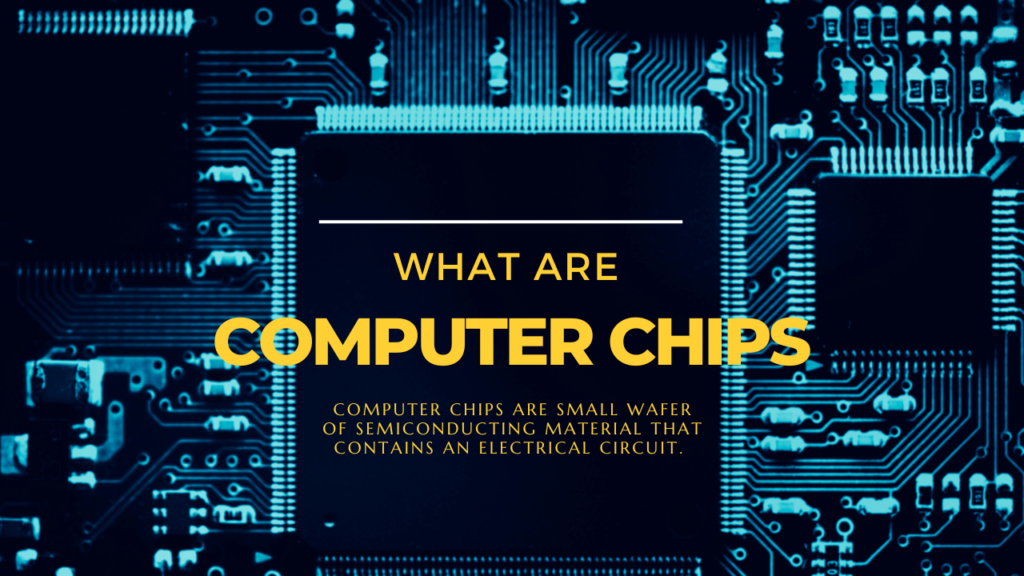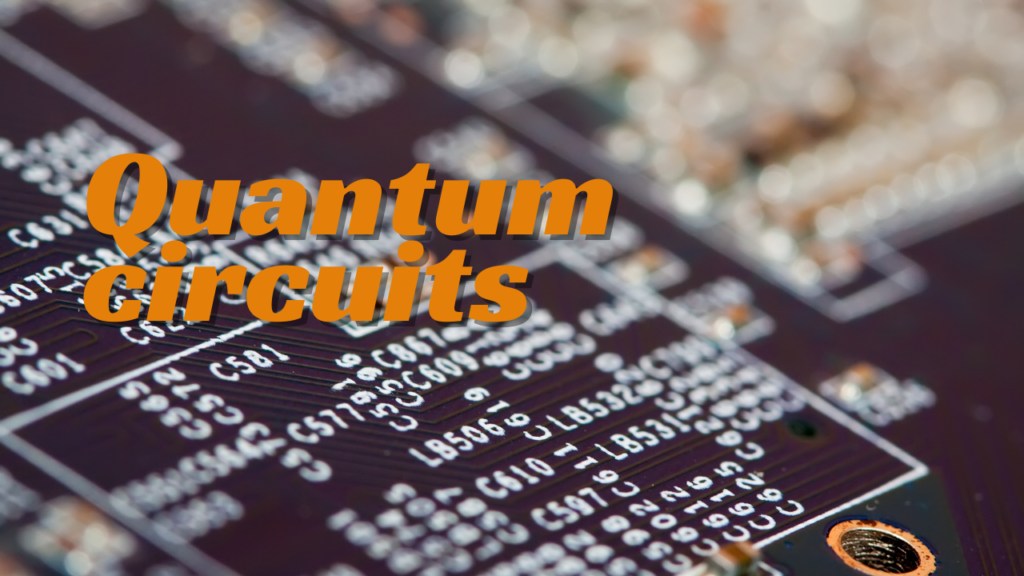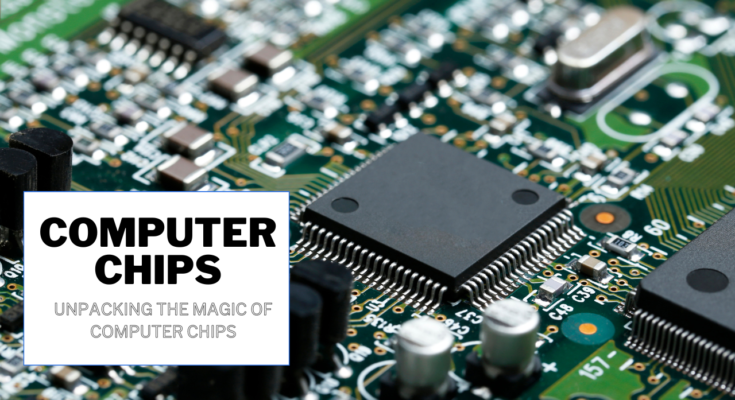What are Computer Chips? Unpacking the Magic of Computer Chips:
Computer Chip:
Computer Chips are small wafer of semiconducting material that contains an electrical circuit. It has millions of small electronic components called transistors that send data messages.

Initially, chips were physically enormous, and computing was only done at national laboratories, universities, or major corporations. Further advancements in computer chip technology resulted in the creation of high-performance processors that power a wide range of advanced analytics, graphics, and machine-learning applications. As the size of the computer chip decreased, it became possible to build smaller computers for use at home. Today, computer chips are everywhere, from microwaves to toothbrushes.
What is a microchip?
Microchips, often known as chips, computer chips, or integrated circuits (ICs), are tiny units of integrated circuitry made from semiconductor materials like silicon or germanium.
Microchip components are so tiny that their dimensions are measured in nanometers. Some components are currently less than 10 nanometers in size, allowing billions of components to be packed onto a single chip. IBM announced a microprocessor in 2021 that uses 2 nm technology, which is smaller than the width of a human DNA strand. A nanometer is one billionth of a meter or one millionth of a millimeter. At such scale, a microchip the size of a fingernail may contain up to 50 billion transistors.
THE HISTORY OF COMPUTER CHIPS.
Computer chips have been around since the 1950s, when Jack Kilby and Robert Noyce invented the first integrated circuit. This invention enabled numerous transistors to be packed on a single chip, transforming the electronics industry. Computer chips have evolved over time, becoming smaller, quicker, and more powerful, resulting in the creation of contemporary computers, cellphones, and other digital gadgets. Today, firms such as Intel, AMD, and Qualcomm continue to push the frontiers of computer chip technology.
How are computer chips made?
Computer chips are often fabricated in facilities known as fabrication plants, or fabs. They are composed of silicon, a common chemical element found in sand. Silicon is a semiconductor, which means its electrical conductivity is intermediate between metals like copper and insulators like glass.
Microchip producers choose silicon because it is abundant, affordable, and simple to deal with. Furthermore, it has shown to be a dependable semiconductor in a range of applications. Silicon, on the other hand, may be approaching its practical limits as microchip technologies shrink and more components are pushed onto the microchip to fulfill the ever-increasing demands for better performance and data. Researchers are currently developing a number of methods that they think will be able to transport electronics into the future.

Microchips often contain the following sorts of components, which can number in the millions or even billions, depending on the type and purpose of the microchip:
- Transistors: Transistors, often known as switches or gates, are active components that regulate, create, or amplify electric impulses inside a circuit. Combining several transistors creates a logic gate that compares input currents and provides a single output based on defined logic.
- Resistors: Resistors are passive components that limit or regulate the flow of electrical current or give a fixed voltage to an active device. Resistors regulate the electrical signals that go between transistors.
- Capacitors: Capacitors are passive components that store electricity in an electrostatic field and release current. Capacitors, along with transistors, are frequently employed in dynamic RAM (DRAM) to assist store data.
- Diodes: Diodes are specialized components having two nodes that conduct electricity in one direction only. A diode may allow or prevent the flow of electric current and can be used in a variety of applications, including switches, rectifiers, voltage regulators, and signal modulators.
A summary of the chip manufacturing process:
Silicon extraction and shaping:
Single crystal silicon ingots are created by melting and refining sand. The ingots are about 100 percent pure. They are sliced into wafer-thin chips, which are then cleaned, polished, and coated with silicon dioxide. To enhance photosensitivity, silicon wafers are coated with photoresist. During this procedure, strict measures are made to prevent dust or other extraneous contaminants from contaminating the product. Once the fundamental silicon chips are complete, electronic circuits are etched onto them.
Circuit etching:
A circuit-patterned plate, known as a mask, covers the silicon wafer and exposes it to ultraviolet radiation. Light hardens the exposed photoresist material in the circuit design. Hot gasses then melt the exposed material, revealing the silicon dioxide below. A 3D landscape is left behind, mirroring the mask’s circuit design pattern.
In chip manufacture, Etching removes layers from the wafer, while doping introduces impurities to change it. Etching and doping can be performed hundreds of times on a single computer chip to generate more intricate integrated circuitry.
Computer Chips Work:
Computer chips work by transmitting electrical signals through the circuit elements.
1. Analog integrated circuits
Analog circuits send continuous, changing signals over a particular time span. The output signal is a linear function of the input voltages that are directly proportional. This type of integrated circuit is utilized for device functions like as timers, comparators, voltage regulators, and operational amplifiers. Analog chips are commonly employed in sweep generators, oscillators, audio amplifiers, and filters.
2. Digital integrated circuits
Digital circuits send discontinuous or binary signals. The output voltage might be high or low. The high voltage represents the Boolean value 1, whereas the low voltage represents the value 0.
Digital circuits provide logical operations such as AND, OR, and NAND. Logical OR, often known as Boolean addition, serves as the foundation for computer addition operations. So, digital integrated circuits are the foundation of all computer activities. They are essential for all programmable devices, including logic boards, microcontrollers, and memory.
3. Mixed-signal integrated circuits
Mixed chips have components of both analog and digital chips. The hybrid architecture allows for chips that function as both digital-to-analog and analog-to-digital converters. These sophisticated integrated circuits are another important part of contemporary computing.
4. Quantum circuits
Quantum circuits represent the next level of computer evolution. A quantum circuit is a computer process that specifies a set of logical quantum operations on the underlying qubits, or quantum bits. Qubits are represented by quantum particles, which are distinct from Boolean digital signals. While Boolean signals may only be 1 or 0, qubits can have several states. Chips containing quantum circuits are the foundation of quantum computing, an emerging technology.

What are the types of computer chips?
Computer chips are classified into four broad categories according to functionality.
1. Memory chips
Computers and storage devices use memory chips to store programs and data. RAM chips provide temporary storage, but flash drives and solid state drives (SSDs) may store data permanently. Flash memory devices can save data even after the electrical current is turned off.
2. Logic chips
Logic or processor chips process data to complete tasks. They are the brains of modern electronic devices. CPUs are the main type of logic chips found in the microprocessors of servers and other computing hardware. However, logic chips can also be designed for specific functions. Here are some examples:
- Graphical processing units are designed to optimize visual displays
- Neural processing units are designed for deep learning and machine learning applications
3. ASICs
Application-specific integrated circuits (ASICs) are intended to conduct repeated processing tasks for a single application. These contemporary chips are manufactured in big batches for single-use devices such as barcode scanners. Another example is bitcoin mining, in which ASICs do the complicated mathematical operations necessary to generate new bitcoins.
4. SoCs
The system on a chip (SoC) is a relatively new form of chip. A single chip contains all of the electronic components required for a complete system. SoC capabilities are more diverse than microcontrollers. A microcontroller typically integrates the CPU, memory, and I/O processing. However, the SoC might include graphics, audio, camera, and video processing.
| Feature | Advantage | Disadvantage |
|---|---|---|
| Size and Weight | Smaller and lighter devices | Limited space for additional features |
| Performance | Faster processing speeds and increased functionality | Can become outdated quickly |
| Power Consumption | More energy efficient designs | High-performance chips can require more power |
| Cost | More affordable due to mass production | Cutting-edge chips can be expensive |
| Integration | System on Chip (SoC) allows for smaller and more efficient devices | Increased complexity can make troubleshooting and repairs difficult |
| Security | Hardware security features can protect against cyberattacks | Vulnerabilities can be exploited if not addressed |
| Environmental Impact | Manufacturing can generate e-waste | Recycling programs can help mitigate this impact |
THE FUTURE OF COMPUTER CHIPS AND THEIR IMPACT ON TECHNOLOGY.
As computer chips improve, their effect on technology will become ever more substantial. Advances in artificial intelligence, virtual reality, and the Internet of Things (IoT) all rely on the development of more powerful and efficient computer processors. Furthermore, the usage of computer chips in areas such as healthcare, transportation, and energy will increase, resulting in new breakthroughs and advancements in these domains. The future of computer chips is bright and full of potential.
CONCLUSION
Computer chips are ubiquitous in our lives, powering everything from cellphones to cutting-edge supercomputers. These modest yet powerful devices process data, store massive amounts of information, and carefully connect numerous components by embedding circuits and transistors into layers of materials such as silicon. Computer chips have revolutionized the electronics industry, from the first integrated circuit to today’s powerful processors. As technology evolves, spurred by innovations in artificial intelligence, virtual reality, and the Internet of Things, the demand for more powerful and efficient computer processors grows.

